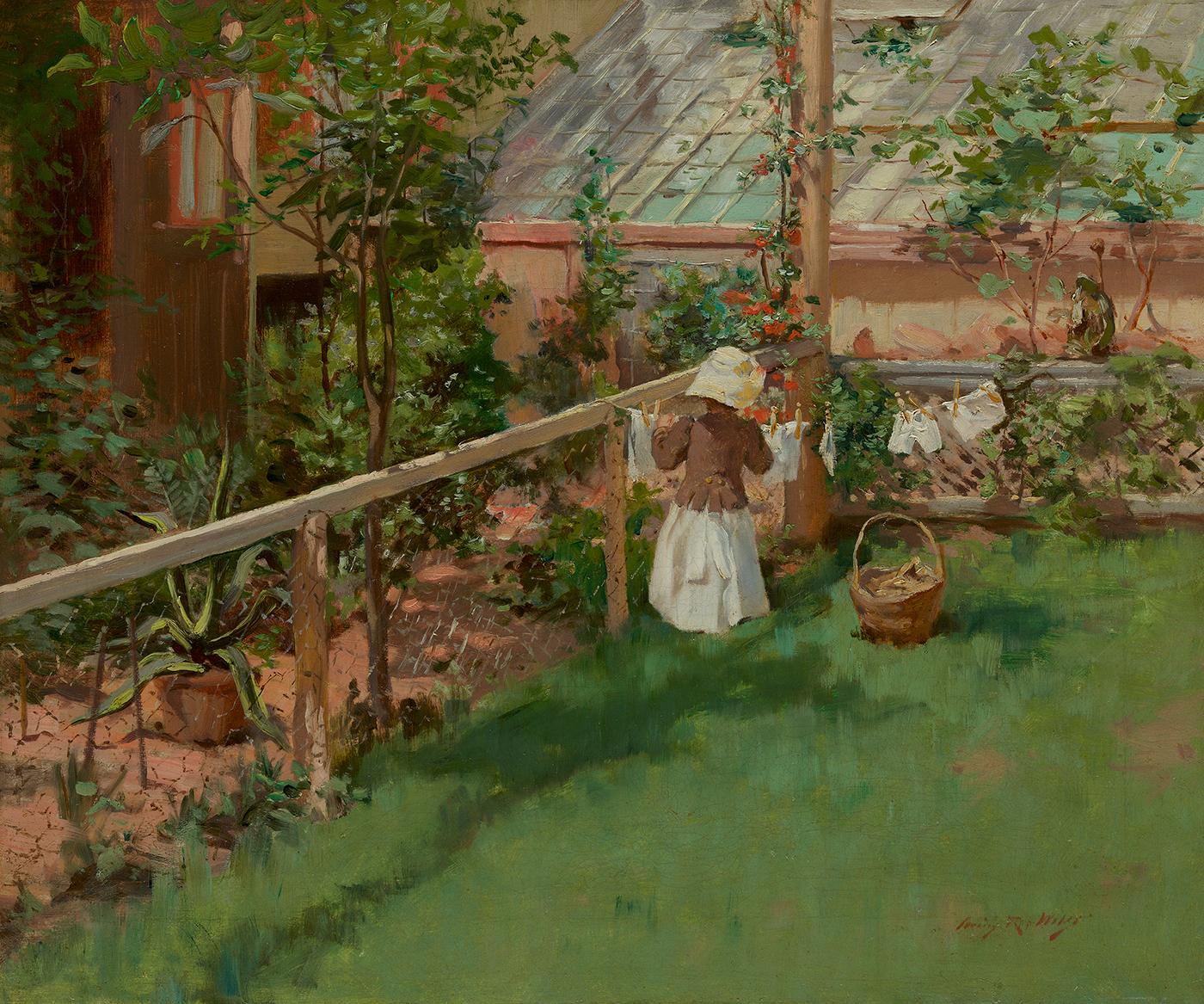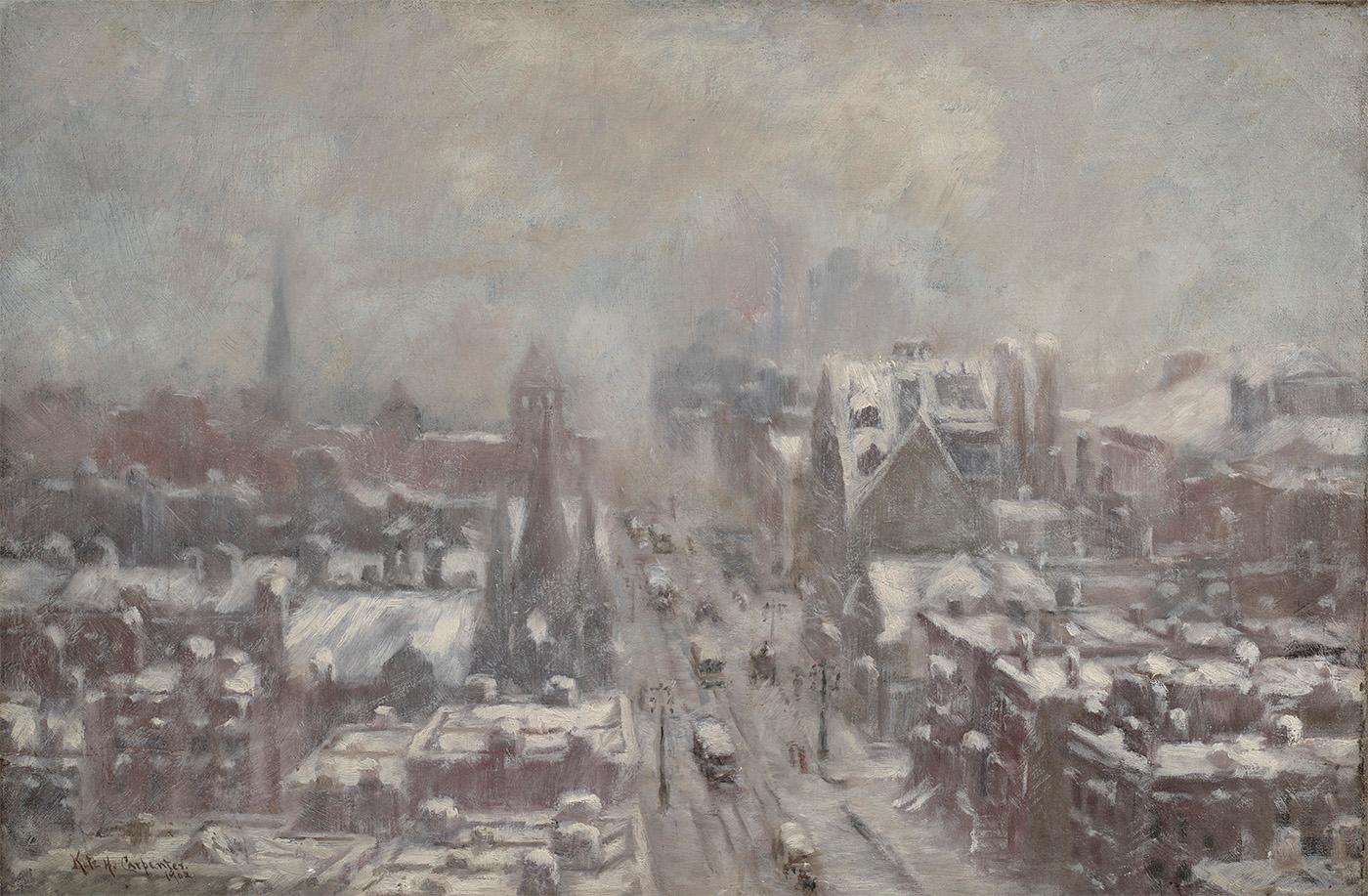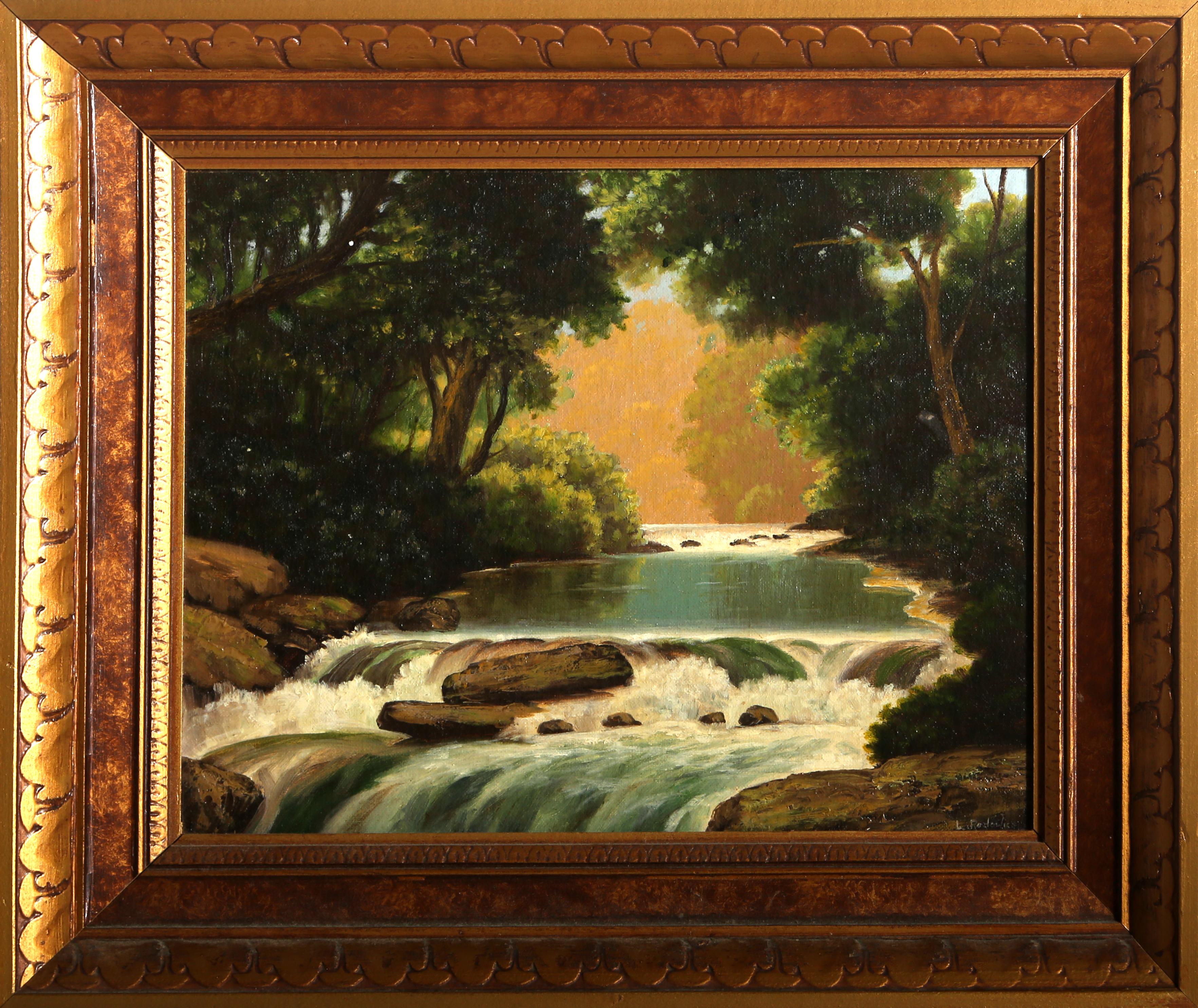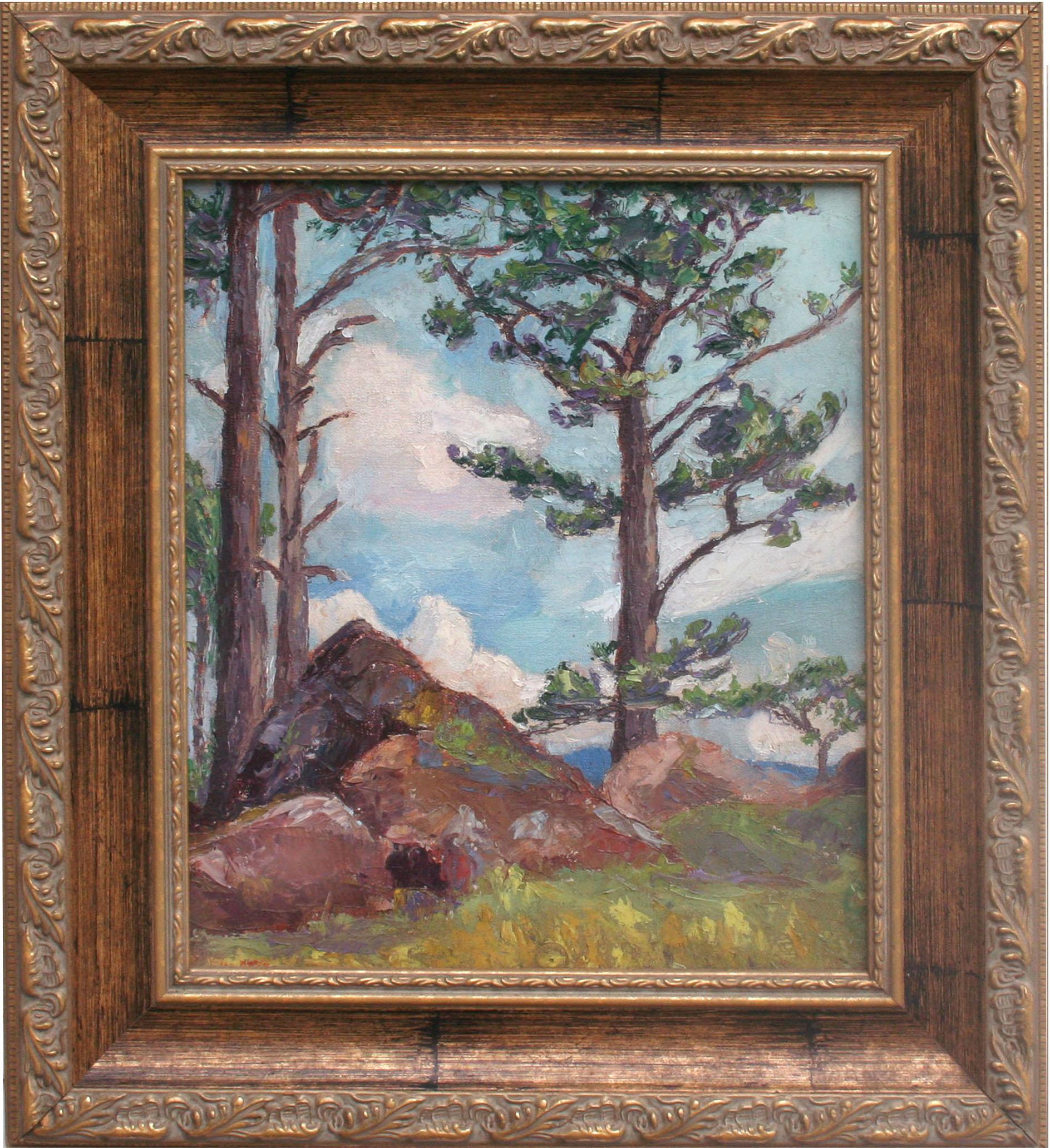Items Similar to "Pennsylvania Dutch Village"
Want more images or videos?
Request additional images or videos from the seller
1 of 7
Walter Emerson Baum"Pennsylvania Dutch Village"c. 1935
c. 1935
About the Item
Jim’s of Lambertville is proud to offer this artwork by:
Walter Emerson Baum (1884 - 1956)
Born in Sellersville, Pennsylvania, Walter Baum was one of the only members of the New Hope Art Colony actually born in Bucks County. Greatly inspired by the painters of the original “New Hope School”, Baum had an extremely profound impact on artistic development throughout the Delaware Valley.
As an artist, there was no other to even come close in matching his highly prolific artistic production. His works were admired by both collectors and aspiring artists. His involvement in establishing an art school and museum in Allentown would have an enormous influence on what would become one of the largest artistic communities in the United States.
It was not until the age of twenty that Baum would begin his art studies first privately with William Trego, a respected local painter, followed by his enrollment to the Pennsylvania Academy of the Fine Arts, where his instructors included Thomas Anshutz and Daniel Garber. He was awarded the Jennie Sesnan Gold Medal from the Pennsylvania Academy in 1925.
Baum taught summer classes for the public schools of Allentown in 1926. The immense popularity of these classes would eventually lead to Baum co-founding the Kline-Baum School of Art in 1929 (later renamed the Baum School of Art). Baum also helped found the Allentown Art Museum in 1936, the Lehigh Art Alliance and the Circulating Picture Club. Baum wrote over five hundred reviews for the Philadelphia Bulletin as wells as Two Hundred Years, a study of the Pennsylvania Germans and their heritage. Baum did much to enrich the cultural environments of eastern Pennsylvania’s past. He received an honorary Doctorate of Humane Letters from Lehigh University in 1946.
During his long career, Baum worked in several mediums and painted in various styles. Many of his earlier works are magnificent impressionist landscapes of Bucks County and the Lehigh Valley showing the strong influence of Redfield and Schofield. Baum developed friendships with Schofield and Garber which deepened his appreciation for the regional landscape. In the late 1940s into 1950s, Baum’s style of painting changed completely, taking on modernist qualities similar to that of the French Post-Impressionist painters. These later works usually depict urban views of Allentown, Bethlehem and Easton as well as figurative works, still lifes and scenes portraying the students in his art classes and studio. Baum actively taught art and promoted artists throughout his life. As art editor of the Pennsylvania Bulletin, he wrote hundreds of reviews.
While he is known for his larger works, Baum painted over a thousand pictures of smaller sizes including extremely detailed 4 x 6-inch miniature landscapes. He would often paint the same scene again and again. Because of his unusually strong work ethic, not all of his many paintings are representative of his potential greatness. When studying his work, it is not uncommon to see several similar views of fair quality and then come upon a fine execution of the same scene. Great painters did not always paint great paintings, and when one was as prolific as Baum, this should be remembered and understood. There has always been a cloud cast upon Baum’s work by less knowledgeable collectors regarding forgeries and paintings finished and signed by the artist’s son. Granted, there are a lot of fake paintings bearing his name, but whether or not his son painted or signed them remains to be seen, but if a painting even looks remotely questionable, it is likely to be at best, of poor quality, and worst case a fake. Either or, this is not the kind of painting a collector should consider buying at any price. A Baum painting of investment quality will look like a fine painting and will not cast any doubt upon the trained eye.
Source: New Hope for American Art, James M. Alterman
- Creator:Walter Emerson Baum (1884-1956, American)
- Creation Year:c. 1935
- Dimensions:Height: 34 in (86.36 cm)Width: 40 in (101.6 cm)Depth: 2 in (5.08 cm)
- More Editions & Sizes:Frame Size 33" x 38"Price: $86,875
- Medium:
- Movement & Style:
- Period:
- Condition:
- Gallery Location:Lambertville, NJ
- Reference Number:
About the Seller
5.0
Vetted Seller
These experienced sellers undergo a comprehensive evaluation by our team of in-house experts.
Established in 1997
1stDibs seller since 2014
36 sales on 1stDibs
Typical response time: 6 hours
- ShippingRetrieving quote...Ships From: Lambertville, NJ
- Return PolicyThis item cannot be returned.
More From This SellerView All
- "The Canal"By Edward Willis RedfieldLocated in Lambertville, NJJim’s of Lambertville is proud to offer this artwork. Signed lower left. Complemented by a hand carved and gilt frame. Illustrated in "Edward Redfield: Just Values and Fine Seeing" by Constance Kimmerle and the Pennsylvania Academy of the Fine Arts's Exhibition of Paintings by Edward Redfield (April 17 to May 16, 1909) brochure Edward Willis Redfield (1869 - 1965) Edward W. Redfield was born in Bridgeville, Delaware, moving to Philadelphia as a young child. Determined to be an artist from an early age, he studied at the Spring Garden Institute and the Franklin Institute before entering the Pennsylvania Academy from 1887 to 1889, where he studied under Thomas Anshutz, James Kelly, and Thomas Hovenden. Along with his friend and fellow artist, Robert Henri, he traveled abroad in 1889 and studied at the Academie Julian in Paris under William Bouguereau and Tony Robert-Fleury. While in France, Redfield met Elise Deligant, the daughter of an innkeeper, and married in London in 1893. Upon his return to the United States, Redfield and his wife settled in Glenside, Pennsylvania. He remained there until 1898, at which time he moved his family to Center Bridge, a town several miles north of New Hope along the Delaware River. Redfield painted prolifically in the 1890s but it was not until the beginning of the twentieth century that he would develop the bold impressionist style that defined his career. As Redfield’s international reputation spread, many young artists gravitated to New Hope as he was a great inspiration and an iconic role model. Edward Redfield remained in Center Bridge throughout his long life, fathering his six children there. Around 1905 and 1906, Redfield’s style was coming into its own, employing thick vigorous brush strokes tightly woven and layered with a multitude of colors. These large plein-air canvases define the essence of Pennsylvania Impressionism. By 1907, Redfield had perfected his craft and, from this point forward, was creating some of his finest work. Redfield would once again return to France where he painted a small but important body of work between 1907 and 1908. While there, he received an Honorable Mention from the Paris Salon for one of these canvases. In 1910 he was awarded a Gold Medal at the prestigious Buenos Aires Exposition and at the Panama-Pacific Exposition of 1915 in San Francisco, an entire gallery was dedicated for twenty-one of his paintings. Since Redfield painted for Exhibition with the intent to win medals, his best effort often went into his larger paintings. Although he also painted many fine smaller pictures, virtually all of his works were of major award-winning canvas sizes of 38x50 or 50x56 inches. If one were to assign a period of Redfield’s work that was representative of his “best period”, it would have to be from 1907 to 1925. Although he was capable of creating masterpieces though the late 1940s, his style fully matured by 1907 and most work from then through the early twenties was of consistently high quality. In the later 1920s and through the 1930s and 1940s, he was like most other great artists, creating some paintings that were superb examples and others that were of more ordinary quality. Redfield earned an international reputation at a young age, known for accurately recording nature with his canvases and painting virtually all of his work outdoors; Redfield was one of a rare breed. He was regarded as the pioneer of impressionist winter landscape painting in America, having few if any equals. Redfield spent summers in Maine, first at Boothbay Harbor and beginning in the 1920s, on Monhegan Island. There he painted colorful marine and coastal scenes as well as the island’s landscape and fishing shacks. He remained active painting and making Windsor style furniture...Category
Early 1900s American Impressionist Landscape Paintings
MaterialsCanvas, Oil
- "Winter Sunlight"By Walter Emerson BaumLocated in Lambertville, NJJim’s of Lambertville Fine Art Gallery is proud to present this piece by Walter Emerson Baum (1884 - 1956). Born in Sellersville, Pennsylvania, Walter Baum was one of the only membe...Category
1930s American Impressionist Landscape Paintings
MaterialsCanvas, Oil
- "Fields in Jersey"By Daniel GarberLocated in Lambertville, NJJim’s of Lambertville Fine Art Gallery is proud to present this piece by Daniel Garber (1880 - 1958). One of the two most important and, so far, the most valuable of the New Hope Sc...Category
Early 1900s American Impressionist Landscape Paintings
MaterialsCanvas, Oil
- "Christmas Time, Sellersville"By Walter Emerson BaumLocated in Lambertville, NJJim’s of Lambertville Fine Art Gallery is proud to present this piece by Walter Emerson Baum (1884 - 1956). Born in Sellersville, Pennsylvania, Walter Baum was one of the only membe...Category
1930s American Impressionist Landscape Paintings
MaterialsCanvas, Oil
- "End of the Day, Gloucester Harbor"By John Fulton FolinsbeeLocated in Lambertville, NJJim's of Lambertville Fine Art Gallery is proud to present this piece by John Fulton Folinsbee (1892 - 1972). One of the finest painters to embark upon the New Hope Art Colony, John...Category
1910s American Impressionist Landscape Paintings
MaterialsCanvas, Oil
- "In Port"By Edward Willis RedfieldLocated in Lambertville, NJJim’s of Lambertville is proud to offer this artwork by: Edward Willis Redfield (1869 - 1965) Edward W. Redfield was born in Bridgeville, Delaware, moving to Philadelphia as a young child. Determined to be an artist from an early age, he studied at the Spring Garden Institute and the Franklin Institute before entering the Pennsylvania Academy from 1887 to 1889, where he studied under Thomas Anshutz, James Kelly, and Thomas Hovenden. Along with his friend and fellow artist, Robert Henri, he traveled abroad in 1889 and studied at the Academie Julian in Paris under William Bouguereau and Tony Robert-Fleury. While in France, Redfield met Elise Deligant, the daughter of an innkeeper, and married in London in 1893. Upon his return to the United States, Redfield and his wife settled in Glenside, Pennsylvania. He remained there until 1898, at which time he moved his family to Center Bridge, a town several miles north of New Hope along the Delaware River. Redfield painted prolifically in the 1890s but it was not until the beginning of the twentieth century that he would develop the bold impressionist style that defined his career. As Redfield’s international reputation spread, many young artists gravitated to New Hope as he was a great inspiration and an iconic role model. Edward Redfield remained in Center Bridge throughout his long life, fathering his six children there. Around 1905 and 1906, Redfield’s style was coming into its own, employing thick vigorous brush strokes tightly woven and layered with a multitude of colors. These large plein-air canvases define the essence of Pennsylvania Impressionism. By 1907, Redfield had perfected his craft and, from this point forward, was creating some of his finest work. Redfield would once again return to France where he painted a small but important body of work between 1907 and 1908. While there, he received an Honorable Mention from the Paris Salon for one of these canvases. In 1910 he was awarded a Gold Medal at the prestigious Buenos Aires Exposition and at the Panama-Pacific Exposition of 1915 in San Francisco, an entire gallery was dedicated for twenty-one of his paintings. Since Redfield painted for Exhibition with the intent to win medals, his best effort often went into his larger paintings. Although he also painted many fine smaller pictures, virtually all of his works were of major award-winning canvas sizes of 38x50 or 50x56 inches. If one were to assign a period of Redfield’s work that was representative of his “best period”, it would have to be from 1907 to 1925. Although he was capable of creating masterpieces though the late 1940s, his style fully matured by 1907 and most work from then through the early twenties was of consistently high quality. In the later 1920s and through the 1930s and 1940s, he was like most other great artists, creating some paintings that were superb examples and others that were of more ordinary quality. Redfield earned an international reputation at a young age, known for accurately recording nature with his canvases and painting virtually all of his work outdoors; Redfield was one of a rare breed. He was regarded as the pioneer of impressionist winter landscape painting in America, having few if any equals. Redfield spent summers in Maine, first at Boothbay Harbor and beginning in the 1920s, on Monhegan Island. There he painted colorful marine and coastal scenes as well as the island’s landscape and fishing shacks. He remained active painting and making Windsor style furniture...Category
Early 1900s American Impressionist Landscape Paintings
MaterialsCanvas, Oil
You May Also Like
- At the ClotheslineBy Irving Ramsey WilesLocated in New York, NYSigned lower right: Irving R. WilesCategory
Late 19th Century American Impressionist Landscape Paintings
MaterialsCanvas, Oil
- Salmon FishingBy John WhorfLocated in Milford, NHA fine impressionist sporting painting with salmon fisherman in a canoe by American artist John Whorf (1903-1959). Whorf was born in Winthrop, Massachusetts and by the age of sixteen...Category
Mid-20th Century American Impressionist Landscape Paintings
MaterialsOil, Canvas
- Cornwall, EnglandBy Hayley LeverLocated in New York, NYSigned and dated lower left: Hayley Lever / 1905Category
20th Century American Impressionist Landscape Paintings
MaterialsCanvas, Oil
- WinterLocated in New York, NYSigned and dated lower left: Kate H. Carpenter. / 1902Category
20th Century American Impressionist Landscape Paintings
MaterialsOil, Canvas
- Creek, Painting by Leonard RodowiczLocated in Long Island City, NYAn original oil on board painting measuring 11 x 14 inches by Polish/American artist Leonard Rodowicz, signed lower right.Category
Mid-20th Century American Impressionist Landscape Paintings
MaterialsCanvas, Oil
- Early 20th Century Pacific Coast Summer LandscapeBy Margaret Wherry ZieglerLocated in Soquel, CABeautiful early 20th century plein air-style landscape by Margaret Wherry Ziegler (American, 1909-1989), c.1930. Trees, rocks, and meadow grass and flowers bask under a blue sky in this sunny summer landscape scene. Signed and dated 1930 on verso stretcher bar. Presented in a vintage wood frame. Image size: 14.25"H x 12.25"W Ziegler was born in Cincinnati, Ohio in 1909 At a young age she traveled with her parents to the Philippines, Japan, India, Italy, Greece, and Europe. She studied art at the Cincinnati Art Academy, Minneapolis Art Institute, the University of the Philippines, and the California College of Arts and Crafts. While in Japan she studied Japanese brush painting...Category
Early 20th Century American Impressionist Landscape Paintings
MaterialsCanvas, Oil
Recently Viewed
View AllMore Ways To Browse
C Dutch
Dutch American
Holland America
Dutch Gold
German Village
Holland Pictures
Large Dutch Landscape
Dutch 1930
Dutch Modernist
French Dutch Style Painting
Landscape Oil Paintings By Dutch School
Dutch Village
Landscape French Village Oil On Canvas
James Dutch
Dutch 1940s
Walter Price
Large Dutch Oil On Canvas
James Holland




